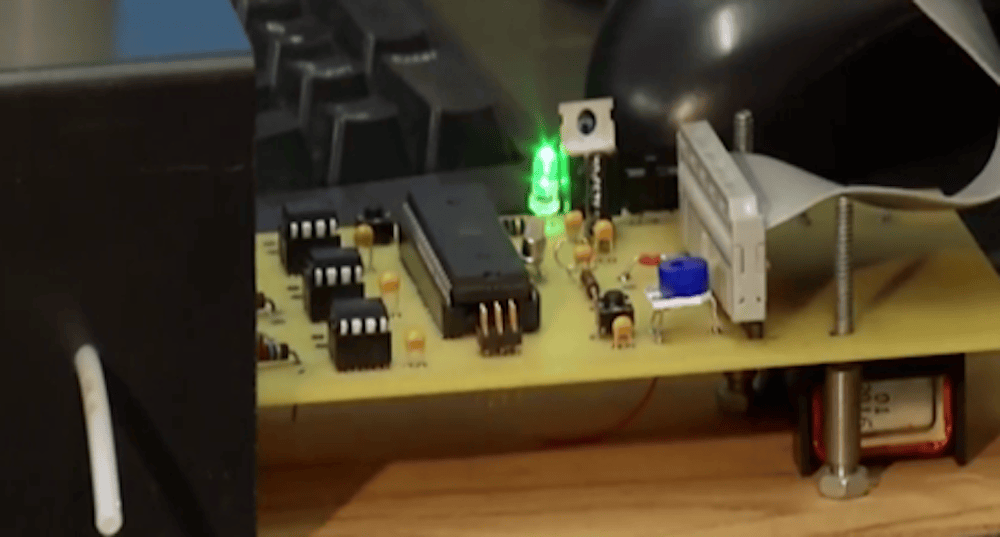
[Image above] The portable, battery-operated breathalyzer prototype to detect COVID-19. Credit: Perena Gouma
In the fight against COVID-19, one of the most difficult challenges faced by the United States is testing—lack of testing, that is.
From a “lost month” of testing at the start to shortages of various testing supplies, the U.S. lagged behind other countries for months in terms of testing capabilities and only recently reached World Health Organization thresholds for testing capacity and positivity rates.
For people who do receive a test, the experience is far from enjoyable. The main technique used to collect samples is a deep nasal swab, a procedure doctors describe as moderately uncomfortable but some patients describe as “being stabbed in the brain.”
Testing methods that are more comfortable and more easily administered would certainly be appreciated by patients, and researchers have explored saliva testing as an alternative, with some promising results. However, according to researchers at The Ohio State University (OSU), there may be an even easier and readily accessible way to administer tests—by using a breathalyzer.
Breathalyzers for medical diagnostics
The idea of using breathalyzers for medical diagnostics may be a new concept for the general public, but the topic is one Pelagia-Iren (Perena) Gouma, Edward Orton, Jr., Chair in Ceramic Engineering and director of the Advanced Ceramics Research Laboratory, has studied for years.
Gouma, who is an ACerS Fellow, began exploring use of breathalyzers for medical diagnostics in 2003, following her invention of a selective ammonia gas sensor that can discriminate and measure ammonia gas in a complex environment.
Her diagnostic breathalyzer concept is similar to an alcohol breathalyzer—inexpensive and easy to use—but it uses selective gas sensing elements to detect certain biomarkers in breath that signal disease.
(“Biological markers,” or biomarkers, are biological substances, characteristics, or images that provide an indication of the biological state of an organism. For example, biomarkers can include physiological indicators, such as blood pressure; molecular markers, such as liver enzymes; and imaging biomarkers, such as those derived from magnetic resonance imaging.)
Compared to swab-based testing methods, Gouma says her method is advantageous as results are available immediately.
“My breathalyzer technology detects the chemical compounds in breath so it is non-invasive, non-intrusive, and will tell you the result within 15 seconds of exhaling into the device,” she says in an email. “Other tests, whether they are called ‘breathalyzers for breath condensates’ or ‘swab-based saliva tests,’ look for biological components in the breath, which require separate testing. Therefore, they cannot compete with my technology.”
With funding from the National Science Foundation, Gouma pursued her breathalyzer concept and soon received a patent on a selective nitric oxide sensor that uses a radical single exhale detection design.
“At that time, the only acceptable breath testing relied on the Sievers NO analyzer that required 30 liters of breath sample, and single exhale sensing was out of the question,” Gouma says. However, single exhale is very important because it gives very reproducible results; in contrast, “multiple exhales change the balance of metabolites in breath, thus giving unreliable results,” she explains.
Since then, Gouma has received tens of other patents on sensors for breath analysis. Overall, she says the field of breath analysis is growing quickly and the medical field is investing in establishing breath biomarkers for various diseases.
Breathalyzers for detecting COVID-19
Gouma started investigating the development of breathalyzers aimed specifically at detecting infectious diseases a few years ago. In 2017, she published an article on a breathalyzer that detected the flu virus, and that research was the basis for the new COVID-19 technology.
The infectious disease breathalyzers use ceramic sensors to target biomarkers, such as nitric oxide and isoprene, that signal infections. The COVID-19 breathalyzer targets biomarkers that give a response specific to that infection and includes advances on nanomaterials for detecting specific breath gases at concentrations that can make a diagnosis.
Gouma says her team initially tested the new breathalyzer by using gas canisters that were mixed to simulate the breath gas mixture as a result of COVID-19 infection. However, they are now conducting human and animal testing and expect to receive emergency use authorization soon to start deploying the device as needed.
Gouma says she is grateful for the support and funding she has received from the National Science Foundation over the years in regard to this research.
“NSF is uniquely positioned to gather a spectrum of scientific input, bringing to bear the best research on our most complex national concerns,” she quotes from an NSF announcement. That is why “it is important that we have our research supported by NSF, as it is deemed to be among the best research on fighting COVID-19 at this time!” she says.
Author
Lisa McDonald
CTT Categories
- Material Innovations


